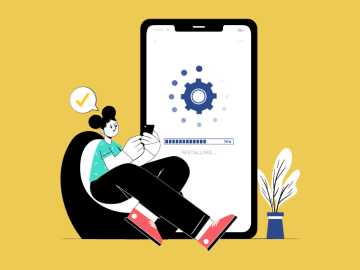Internet users are growing tremendously, with over 1 million daily active users, as per 2019 statistics from WeAreSocial. We don’t need to convince you that the growth rate has increased even more over the past few years. Mobile and desktop usage are driving this growth. Each channel, however, has its own advantages and disadvantages.
This article highlights the latest developments in mobile vs. desktop usage trends, vital growth statistics, and other relevant information about both sectors.
Let’s dive in.
Overview of Mobile and Desktop Usage
According to current research by Internet World stats, 4.53 billion people, or nearly 58.8% of the world’s population, can now access online web portals. Thankfully, in comparison to the conventional age, people now have more ways than only desktop computers to browse the World Wide Web by using newer, more advanced technologies.
Today, many people use mobile devices for online shopping, web access, and other tasks. Worldwide organizations are also becoming highly interested in using learning management systems and integrating mobile learning.
Comparing Mobile and Desktop Devices
BroadbandSearch’s analysis of internet usage on mobile and desktop shows a progressive shift in web traffic over the years. Mobile internet usage accounted for 51.3% of all website traffic in 2016 and 53% in 2019.
Although desktop online traffic continued to dominate at 56.7% during the same period, statistics indicate that mobile internet usage is increasing steadily and may soon overtake desktop usage.
The survey also offered an intriguing look at how mobile users behave, demonstrating that 90% of their internet activity is spent on mobile-specific applications. The popularity of smartphones and tablets doesn’t mean desktop computers are going out of style. Every piece of equipment has a function inside the technological ecosystem.
Smartphones and tablets are the best devices for on-the-go jobs and casual surfing because of their higher flexibility and portability. Desktop computers and laptops continue outperforming them regarding resource-intensive and complex computing tasks.
According to the changing environment, developers must know the differences between desktop and mobile experiences. They should put more effort into developing platform-specific responsive designs and optimized applications to appropriately cater to distinct user needs.
Differences Between Mobile and Desktop Experience
All mobile, desktop, and tablet devices have seen higher conversion rates during the last five years. Desktop users had the most significant percentage of 4.14%, according to BroadbandSearch, indicating a higher propensity to buy. The conversion rate for tablet users was 3.36%, while it was 1.53% for mobile users.
For the best user experience, we’ll pay attention to elements like portability, specialized apps, and wireless connectivity, which are more important than the distinctions between desktop and mobile.
Portability
The dispute between mobile and desktop devices mainly favors the former because of changing usage patterns. More users now prefer mobile devices for social media surfing, news reading, email, and online purchasing. According to research by BroadbandSearch, people watch media on their mobile devices for about 203 minutes per day.
Dedicated Apps
Mobile devices include specialized software for various tasks, including social networking and business tools. They provide mobile-friendly tools for talented kids and cater to employees who must complete tasks while on the go. On the other hand, desktop programs shine in categories like video editing, graphic design, education, production, and IT development because they have simple navigation and excellent graphic layouts.
Wireless Connections
The wireless connectivity of desktop and mobile devices is a crucial distinction. Cellular networks are simple for mobile devices to connect to, enabling continuous web access. On the other hand, desktop PCs rely on WiFi connections to access the Internet.
Advantages and Disadvantages of Mobile Usage
Mobile phones have evolved from simple communication tools to complex gadgets that provide high-quality media capabilities, storage space, longer battery life, and cutting-edge wireless technology. According to LMS trends, mobile phones are increasingly used globally in educational activities, communication, entertainment, and online commerce.
Mobile Device Advantages
Mobile phones are essential in various spheres of the world, such as classrooms, workplaces, and general household functions. Its advantages are enormous, and they offer features that every user desires. Two of these significant feature includes:
Convenience
Users often interact with mobile devices, which have evolved into essential everyday tools. A Dscout research found that the typical person touches their phone 2,617 times daily. This exemplifies how mobile devices enable connectivity and provide users with security.
Multi-purpose Features
Mobile phones were initially created to provide wire-free, hands-free communication. They have now developed into versatile gadgets. Versatile gadgets can perform various tasks, including communication, entertainment, storage, and applications.
Mobile Device Disadvantages
It’s not always rosy for mobile device users, and the challenges they experience could go on and on. Mobile phones are limited to an extent, and here are some common focus areas.
Screen Size
Mobile phones possess small screens, which are typically five to six inches. This minute size, in comparison to desktops, is their primary flaw. While they are sufficient for simple daily operations, more than these screens might be needed for more complex jobs like recording, utilizing PC screen recorder software, or doing far screen-extensive tasks.
Constant Interruptions
While allowing for constant communication, mobile devices can also provide frequent disruptions and distractions, which disrupt productivity and attention to everyday chores. Even the continuous buzzing of mobile notifications can negatively impact people’s capacity to remain productive.
According to an OfficeTeam study, mobile devices are a significant source of office distractions, with each employee wasting approximately five hours per week or 56 minutes per day on non-work-related activities. Additionally, users pick up their phones 58 times on average daily, 30 of which occur at work.
Advantages and Disadvantages of Desktop Usage
The Advantages of Desktop Usage
Computer systems like laptops nowadays are handier and more portable than the large computers of the mid-1960s that required massive space. Handy computer types like laptops are convenient and give users the flexibility and liberty to work on anything with a computer at any given time.
Since the introduction of portable computers in the 20th century, the device has evolved into a dominant computing machine, containing ingenious functionalities, lustrous and lightweight designs, and the most current and famous operating systems.
According to the Nelson Norman Group research, large-screen devices like desktop computers and laptops are preferable for performing complex, challenging, and overwhelming tasks.
Research carried out by BroadbandSearch indicated that in the daily average desktop use in 2013, people in the US used a desktop in 144 minutes, while in 2019, they used a desktop in 128 minutes.
Following ResearchAndMarkets, the rate of buying and selling of laptops will increase. Its market is expected to grow to $7.2 billion from 2020 to 2024. Other advantages of desktop devices in accomplishing several tasks
Business Tools
More portable devices, like mobile devices, cannot perform some duties, which gives desktop devices an advantage. For example, desktop devices can be used for companies’ business processes like accounting, product creation, marketing, administration, and animation.
Better Performance
Desktop devices are better than mobile devices regarding performance, power, and reliability. Higher storage capacity gives users ample space to handle media, software programs, and many other files.
The Disadvantages of Desktop Usage
Desktop computer devices and laptops are associated with risks like durability, security, lifetime, and hardware issues, including storage, backup, and battery. Users may encounter the following disadvantages in desktop devices.
Requires Too Much Space
Carrying desktop devices from place to place is more complicated due to their size. Users who need to travel regularly may find them too huge to carry around.
Durability
Changes and developments in electronic devices, including desktop computers and laptops, since their first introduction, have given them different sizes, options, features, styles, and a wide variety of choices to select from.
These devices are more disposed to wear and tear. Studies by SquareTrade show that laptops have far more delicate and stylish components than other electronic devices, so they are predisposed to a higher failure rate than other consumer electronics. The study also revealed that one-third of all laptops experience fault within three years. Some laptop parts, such as power jacks, screen hinges, and latches, can weaken eventually.
Current Statistics on Mobile and Desktop Use
According to Statcounter Global stats of mobile to desktop website usage, it is discovered that 50.48% of web traffic is from mobile devices, and 46.51% of web traffic is from desktop devices. Tablets contribute the lowest with traffic of 3%.
The United States has online traffic of 63% from tablet and smartphone devices. This is based on data recorded in 2017 of 2 trillion site visits, a significant rise from 57% in 2016. By the close of 2018, there was an expectancy increase of two-thirds.
Ad Viewership
According to Buiness2Community’s research, the percentage of ad viewership by mobile users compared to desktop users was tremendously high, with mobile users leading at 83% while desktop and laptop computer users were 53%. This is because the Internet has better desktop ad blockers, which makes advertising campaigns efficiently target mobile users.
Mobile Learning
According to LearnDash, mobile learning is fast becoming an essential aspect of e-learning. 70% of mobile learners are becoming more motivated when training using a mobile rather than a desktop device.
E-commerce Transactions
According to statistics from Merchant Savvy, 58% of multi-device purchases in 2020 utilized mobile devices to generate sales. Users prefer using their mobile phones for ease and better availability than desktops while browsing online. Movies, computer hardware, video games, and digital content have the most significant purchase of mobile share and have the fastest growth in e-commerce.
Global mobile trends reveal that in the US, mobile phones opened 61% of email, 24% of webmail clients, and desktop devices at 5%.
Social Media Surfing
Out of every five minutes spent using online content, at least one minute goes into surfing social media. Social media is primarily accessed through mobile phones, accounting for 25% of digital media usage.
Google Searches
As per Hitwise‘s research, 58% of searches on mobile devices are done using Google searches. According to an analysis done in the industry on search volumes, it has been proven that most search queries globally were created from mobile browsers. Also, 72% of searches are related to food and beverages.
Engagement Rate
When comparing mobile apps with desktop web viewing, it has a greater engagement rate and conversion rates of about 100-300%. This proves that in terms of user engagement and conversion, mobile apps triumph over mobile-improved websites, according to mobile marketing magazine.
It has been discovered that the engagement matric of mobile apps differs based on the market maturity and the population of the mobile market at the regional level. Western Europe region from 2019 – 2020 emerged as the utmost direct app with open rates of 40.6%.
Web Loading Time
Loading time is necessary for mobile users. 53% of mobile users discontinue websites that take more than 3 seconds to load. This emphasizes how crucial mobile page speed ensures excellent user experience, reminding web developers of the relevance of mobile-responsive websites.
Conclusion
In the past, nothing was more dominant and influential than a desktop computer. Mobile usage is overtaking desktop usage. Due to information technology advancements, more ways to connect and interrelate over the Internet have emerged. There are now unlimited options for online marketing, casual browsing, and e-commerce transactions.
Mobile usage is higher than desktop usage in terms of number of users and web traffic. Most times, the primary factors in choosing whether to use a desktop or mobile device are transportability, convenience, suitability, and screen size. Big-screen devices like desktops and laptops are still powerful and will not be obsolete anytime soon. The majority of users still prefer to undertake some internet-based tasks on big screens regardless of the more sophisticated mobile devices on the market today.
FAQs
Are computers or phones used more?
6.06 billion people used smartphones globally in 2020. By 2026, the population use of smartphones will hit 7.69 Billion. Across all industries, workers increasingly depend upon smartphones.
What is the percentage of mobile users?
92.3% of internet users make use of mobile phones. There are about 4.32 billion active users of the Internet through mobile phones.
Why are desktops good than phones?
Compared to phones, desktops and computers are more reliable. They have wider screens and larger storage space.
References

 Our Editorial Process
Our Editorial Process
The Tech Report editorial policy is centered on providing helpful, accurate content that offers real value to our readers. We only work with experienced writers who have specific knowledge in the topics they cover, including latest developments in technology, online privacy, cryptocurrencies, software, and more. Our editorial policy ensures that each topic is researched and curated by our in-house editors. We maintain rigorous journalistic standards, and every article is 100% written by real authors.









